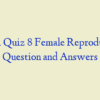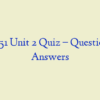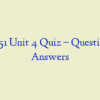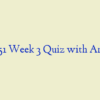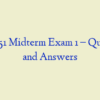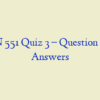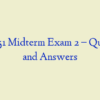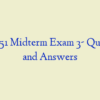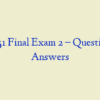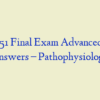Description
MN 551 Unit 6 Quiz Question and Answers
Unit 6: Disorders of the Gastrointestinal and Genitourinary Systems in Primary Care Exam 6 Time Remaining: Save Answers Submit for Grading
- A 35 year old female patient is seen in the clinic complain of abdominal pain. Which of the following should be include in the history and physical exam?
- A patient is seen in the office and is complain of constipation. The patient lists all of the following medications. Which drug could be responsible for the constipation?
- A patient with complaints of diarrhea is ….. Which of the following should be included on the differential diagnosis list for a patient with diarrhea?
- J. K., 38 years old, is 5 feet 8 inches tall and weighs 189 pounds. He reports that he has had intermittent heartburn for several months for which he takes Tums with temporary relief. He has been waking during the night with a burning sensation in his chest. Which additional information would lead you to believe that gastroesophageal reflux disease (GERD) is the cause of his pain?
- A 29 year old Englishman is seen in the office with complaints of pain in his chest and belly for 2 weeks. He gets temporary relief from Alka Seltzer. The burning pain wakes him at night and radiates up into his chest. Which factor favors a diagnosis of gastric ulcer?
- Which of the following is most effective in diagnosing appendicitis?
- A 45 year old patient presents with a chief complaint of generalized abdominal pain. Her physical exam is remarkable for left lower quadrant (LLQ) tenderness. Which of the following should be considered in the differential diagnosis at this time?
- A 46 year old female is …in the clinic with abdominal pain. Which of the following tests is essential for this patient?
- Which of the following is associated with celiac disease (celiac sprue)?
- A 25 year old accountant is ….in the clinic complaining ofcrampy abdominal pain after meals. She is often constipated and takes laxatives. Following this, she has diarrhea for a couple of days. She temporarily feels better after a bowel movement. She-states she is embarrassed by flatulence and has abdominal distension. She has had no weight loss or blood in her stool. This problem has gone on for about 6 months. What should the next step be?
- A 28 year old patient is ….in the clinic with colicky abdominal pain, particularly with meals. She has frequent constipation, flatulence, and abdominal distension. Which of the data make a diagnosis of diverticulitis unlikely?
- A 28 year old patient is ….with complaints of diarrhea. Which of the following questions would help the clinician establish the diagnosis of irritable bowel syndrome?
- A patient is diagnose with gastroesophageal reflux disease (GERD), and his endoscopic report reveals the presence of Barrett’s epithelium. Which of the following information should the clinician include in the explanation of the pathology report?
- Which of the following dietary information should be ….to a patient with gastroesophageal reflux disease (GERD)?
- The patient with gastroesophageal reflux disease (GERD) should be ….to eliminate which of these activities?
- A patient is diagnose with Giardia after a backpacking trip in the mountains. Which of the following would be the appropriate treatment?
- A 22 year old is seen complain of vague belly pain. This type of pain is seen at what point in appendicitis?
- The clinician suspects the patient has a peptic ulcer. Which of the following items on the history would lead the clinician to this conclusion?
- A patient is seen and a urine sample is take. The urine dipstick reveals a high level of bilirubin, and the urine is dark color. Which of the following could be a cause of this problem?
- A 21 year old student presents with a chief complaint of fatigue, headache, anorexia, and a runny nose, all of which began about 2 weeks ago. She started taking vitamins and overthecounter (OTC) cold preparations but feels worse. The smell of food makes her nauseated. Her boyfriend had mononucleosis about a month ago, and she wonders if she might have it also. An examination reveals cervical adenopathy and enlarged liver and spleen. Which of the following laboratory tests would be most helpful in the differential diagnosis at this point?
- On further questioning, the 21 year old patient with the chief complaints of fatigue, headache, anorexia, and a runny nose explains that she is sexually active only with her boyfriend, does not use injectable drugs, and works as an aide in a day care center. Which of the following tests would be most helpful in confirming your diagnosis? mn 551 unit 6 quiz
- A patient is ….In the clinic with right upper quadrant (RUQ) pain that is radiating to the middle of the back. The clinician suspects acute cholelithiasis. The clinician should expect which of the following laboratory findings?
- The patient has acute pancreatitis with 7 of the diagnostic criteria from Ranson’s Criteria. In order to plan care, the clinician understands that this criteria score has which of the following meanings?
- A patient is …in the office with complaints of six to seven liquid bowel movements per day. Which of the following assessment findings would lead the clinician to a diagnosis of inflammatory bowel disease?
- Which of the following is part of the treatment plan for the patient with irritable bowel syndrome?
MN 551 Unit 6 Quiz Set 2
- Chronic anxiety and stress contribute to ulcers. Which of the following effects of the sympathetic nervous system is most responsible for this effect?
- Which of the following patients is most clearly displaying the signs and symptoms of IBD?
- A 24-year-old woman undergo a premarital screening test is …to have elevate levels of AST, ALT, and IgG, but no antibody-specific markers for viral hepatitis. A liver biopsy reveals inflammation and cellular damage. Which of the following treatments is most likely to be effective for her?
- Which of the following statements best captures an aspect of the process of fat digestion and absorption?
- A 40-year-old female has been categorize as being obese, with a BMI of 33.2. Which of the following health problems is the patient at a significantly increase risk for compared with individuals with a BMI below 25?
- David has an acute exacerbation of Crohn’s disease. Which of the following lab tests would you expect to be decreased with Crohn’s Disease?
- A 51-year-old male professional is in the habit of consuming six to eight rum and cokes each evening after work. So, he assures the nurse practitioner, who is performing his regular physical exam, that his drinking is under control and does not have negative implications for his work or family life. How could the nurse best respond to the patient’s statement? mn 551 unit 6 quiz
- A nurse practitioner is providing care for a male patient with a long-standing hiatal hernia. Which of the following statements most accurately captures an aspect of the pathophysiology of hiatal hernias?
- As a result of oral ingestion of the microorganisms, an individual has contracted H. pylori. Which of the following health problems is the individual now at increased risk for?
- A 43-year-old male who is 5 feet 10 inches tall and weighs 216 pounds has been informed by his nurse practitioner that his body mass index (BMI) is 31. Which of the following clinical conclusions based on these data would his nurse be most justified in rejecting?
- A 20-year-old male who is addict to crystal methamphetamine has been admit to the hospital with a diagnosis of protein-calorie malnutrition after many months of inadequate food intake. Which of the following treatment plans would the care team most likely favor?
- As part of the intake protocol at an eating disorders clinic, an interview precedes a physical examination. Which of the following questions would a clinician be justified in excluding from an intake interview for a 16-year-old female referred by her pediatrician for the treatment of anorexia nervosa?
![]()

